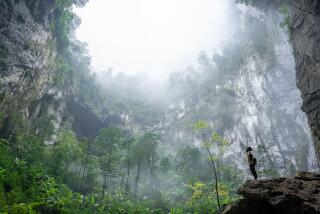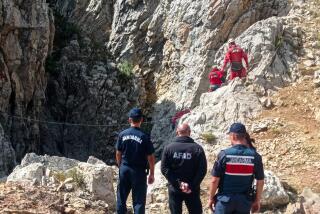Caves can’t hold back U.S. forces, analysts say
(RealVideo and QuickTime)
WASHINGTON — When the Soviet Union took on Afghanistan, its troops found themselves crawling, terrified, through a vast network of mountain caves studded with knives and booby traps, pursuing moujahedeen fighters who seemed to melt into mountainsides like the night itself.
Although Taliban leaders claim that they will use the same tactic to thwart the United States, their ability to do so when confronted with sophisticated weaponry and highly trained forces may be more myth than reality, former and current defense officials and military analysts say.
Defense officials acknowledge that there are hundreds, if not thousands, of caves, tunnels, aqueducts and bunkers in the mountains and deserts of Afghanistan, the legacy of centuries of warfare and of an ancient farming technique that relies on underground water supplies.
But if fighters loyal to the Taliban and Osama bin Laden hole up inside mountains to escape U.S. forces and the bitter Afghan winter, reconnaissance planes equipped with thermal-guided cameras can spot them sitting around fires. Laser-guided missiles on Talon gunships can be trained on them.
The meticulous preparations being made by U.S. military planners to weaken the defenses of the Taliban and the al-Qaida terrorist network suggest that they have learned from Soviet mistakes. With the vastly more sophisticated technology at their disposal, finding the enemy in the highlands of Afghanistan is still likely to be difficult, but far from impossible, analysts believe.
“On a purely technological level, the U.S. military is prepared to find and destroy these caves,” said John Pike, director of GlobalSecurity.org, a defense policy research firm in Alexandria, Va. “But the notion that we can find bin Laden’s “fortress of solitude’ and that all 5,000 of his henchmen are going to be down there among the stalactites, you know, it’s just ridiculous. The caves are going to be just one of many, many places these people could be.”
Pentagon planners are aware of such limitations. Senior defense officials have cautioned publicly in recent days that the Taliban and al-Qaida may be hiding fighters and weaponry not in caves, but in homes, markets and mosques in the middle of villages and cities.
But they remain convinced of the need to eventually strike at mountain and desert hideaways.
“Caves are clearly in target sets, because that’s where al-Qaida has traditionally hidden,” said Rear Adm. John D. Stufflebeem, a senior official with the Joint Chiefs of Staff.
Found primarily in eastern and southern Afghanistan, most famously in Paktia province near the Taliban stronghold of Kandahar, the hide-outs include natural limestone caverns and tunnels and man-made passageways, said geologist Jack Shroder of the University of Nebraska at Omaha. Shroder has extensive experience working as a scientist in Afghanistan.
Some of the narrow passageways stretch for miles and lie deep under the rock, Shroder said. Others are little more than bunkers just under the surface, 10 to 30 feet deep.
Still, for all the complexity of this system, most experts on Afghanistan and military weapons don’t believe it is formidable enough to deter the U.S. special forces preparing to launch a series of ground raids this winter.
Much of the image of the caves as impenetrable was forged during the Soviet invasion of Afghanistan. But the ill-equipped and ill-trained Soviet conscript army made mistakes that U.S. military planners are unlikely to repeat, said Mark Kramer, a professor of Russian studies at Harvard University.
“The Soviet military and the U.S. special forces are just simply not analogous forces. The elite American teams are a modern, professional fighting force,” Kramer said. “That’s not to say that this is not going to be tough, but let’s be careful where we draw our analogies from, or we can draw the wrong lessons from history.”
Still, the Soviets made impressive gains in locating the mountain hideaways, said Sarah Mendelson, a senior fellow at the Washington-based Center for Strategic and International Studies and the author of a book on the Soviet war in Afghanistan.
Mendelson and Kramer both said they believe that outside developments -- most obviously the strains within the Soviet Union that led to its collapse -- were key to stymieing the Soviets in Afghanistan.
“It is conventional wisdom that the Afghans beat the Soviets, and the reality is just much more complex,” Mendelson said.
The United States is in a far better position than the Soviets were to neutralize the cave threat, military analysts say. For more than 10 days, for instance, U.S. warplanes have been dropping 5,000-pound laser-guided “bunker buster” bombs developed for the 1991 Persian Gulf War.
To detect the caves, the CIA’s Gnat and the Air Force’s Predator and U-2 unmanned reconnaissance aircraft have been equipped with high-accuracy ASARS-2 radars for use in Afghanistan, one defense industry official said.
When cold weather comes to the mountains of Afghanistan, the Pentagon plans to outfit low-flying helicopters with thermal-guided cameras designed to detect and photograph hot spots underground, the defense official said. Then AGM-130 missiles designed for horizontal flight can be directed into tunnel mouths.
“You can basically imagine the gunships just going out at night looking for warm spots on mountainsides,” Pike said. “They can detect a group sitting around a fire, just by the body heat and the heat of the fire. Anybody who’s betting that they can’t do that might be surprised.”
More to Read
Sign up for Essential California
The most important California stories and recommendations in your inbox every morning.
You may occasionally receive promotional content from the Los Angeles Times.










